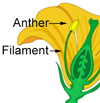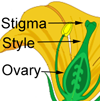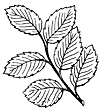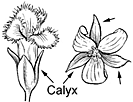Leptecophylla tameiameiae
Heather family (Ericaceae)
Native species (indigenous)
Pukiawe is a large shrub or sometimes small tree when in the understory of wet forests. Common through the islands from low to high altitudes. Recognized by the small needle-like leaves whitish beneath, very small whitish flowers, and small round red, white, or pink

©2016 Forest And Kim Starr
Leaves many, scattered and spreading along twig on tiny hairy yellowish leaf-stalks. Blades bent at right angle to twig, very narrow (linear to oblong), 1⁄4–1⁄2 inch (6–13 ) long and 1⁄8 inch (3 ) or less in width, sharp-pointed, rounded at base, turned under at edges, slightly thickened and stiff, hairless, upper surface dull green without visible veins, lower surface whitish, with many long fine nearly parallel veins.
Flowers few, single and almost stalkless at leaf bases, bell-shaped, 1⁄8 inch (3 ) long and and wide, composed of several overlapping at base; with five overlapping hairy green and pinkish tinged; white bell-shaped tubular with five spreading narrow pointed five tiny in notches of and with rounded short and dot
(berries) several at leaf bases, round, 3⁄16–1⁄4 inch (5–6 ) in diameter, red, pink, or white, slightly shiny, with at base and at slightly fleshy, mealy, tasteless or slightly astringent, becoming brown and dry. Seed or stone single, elliptical, brown, more than 1⁄8 inch (3 ) long.
Sapwood is light reddish brown and heartwood dark reddish brown. A fine-textured heavy wood of moderate hardness.
The wood was used for cremating bodies of outlaws. Also, according to Hawaiian historian David Malo, when a high ranking chief wanted to mingle with commoners, he would enter a smoke house and be smudged with smoke of pukiawe wood while a priest chanted a prayer for dispensation.
The bright beadlike served in Hawaiian garlands or leis.
Common and widespread from the understory of wet forests to the border of dry forest and exposed ridges and waste places, from near sea level to 10,600 ft (3231 ) or above. Of largest size in forests at 5000–6000 ft (1524–1829 ) and almost creeping in bogs. It is very common in Hawaii Volcanoes and Haleakala National Parks. In pastures and rangelands at higher altitudes classed as a weed of no forage value (Hasselwood and Motter 1966).
Special areas
Kokee, Haleakala, Volcanoes
Range
Through the six large Hawaiian Islands and in Marquesas Islands
Other common names
maiele, kāwa‘u, ‘a‘ali‘i-mahu, kawai, Kamehameha styphelia, Hawaiian heather, kānehoa, pūpūkiawe, puakiawe
Botanical
Styphelia tameiameiae (Cham. & Schlecht.) F. Muell., Styphelia douglasii (Gray) Skottsb.






